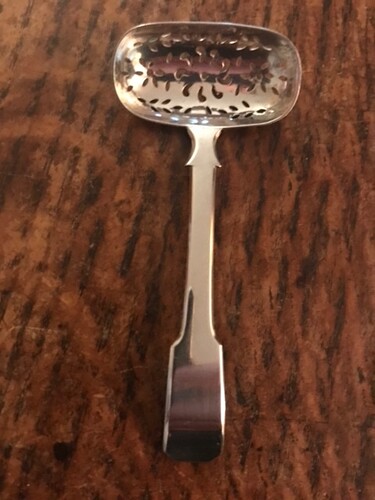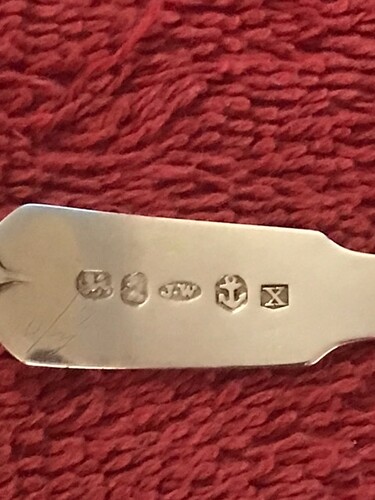Thank you for reading my post and responding. By 1820 Britain was importing 2.8 million pounds of tea from China. The tea clippers brought various qualities and types of tea into your country.
One of the anomalies of most tea caddy (a muddled translation from the word “Katy” or box or container.) spoons is they only work for the black tea leaves which have been cut into the small “leaves” people like Sir Thomas Lipton conditioned us to expect.
When you visit China and buy tea there it comes in large dried cubes of pressed together leaves which, when you separate them and pop them in your favorite silver 18th century teapot, are about the same size as leaves on a mint plant and the caddies are completely useless to extract them.
The clue is the grid of holes and their size governing entry to the spout of teapots after about 1760.
They are far smaller than necessary and designed to replace the mote spoon which had been used to remove accumulated debris from spouts and to stir tea when it was first introduced to Europeans in the 17th century.
All of this is somewhat tangental to you excellent point. But I am wondering why, having bought what amount to the sweeping off the dying floors, the lady of the house would elect to sift out the debris in her tea salon and where she would put the dust when separated?
We are used to seeing bowls for deposit of steeped tea leaves remaining in a cup after drinking but I don’t think these bowls were used for depositing dried out tea dust before it went into the pot.
It has been suggested the implement in question may not be for tea at all but for one or more of the spices then imported from the so-called East Indies meaning Java or modern Indonesia.
The habit of mixing a little powdered mustard with water and dolloping on the side of your plate or directly on roast or boiled beef was fairly new, powdered mustard from blind casters having been used widely up until about 1750.
Sugar, okay not a spice, but then imported in cakes and hammered into a powder in the kitchen might have used such a sifting device although generally the sifters of the day were ladle-sized.
The Chinese tea sellers were acutely aware of two things about the Europeans buying tea; first, they were mildly addicted to the stuff – the alternates in the UK then being beer or cholera from bad wells, and secondly they could and did demand silver which the British still had a lot of having traded for it in the notorious triangle trade out of Bristol.
The British solution to this drain on its silver supply was to import opium from India and addict the Chinese to it, creating a new triangle trade this time based on drugs rather than humans.
This in turn triggered the Boxer wars (the Brits called them rebellions) and by the time of Chairman Mao chucking the Brits out of the country.
Today China looks to BRI its newly powerful empire into European takeover which is of course why it is funding Russia to deal with Ukraine which it regards as a gateway.
Britain is about to elect Mr Starmer as its new PM and his task will be to strengthen Britain against the pending Chinese incursions. To this end he has to stop the money laundering which seems to be the main enterprise of your London merchant bankers just now.
How does all this modern history relate to your comments about “All the tea in China” and this tiny implement? Well as someone smarter than me once said if you want to see the future look carefully at the past.

